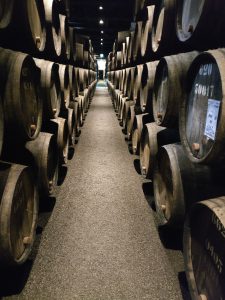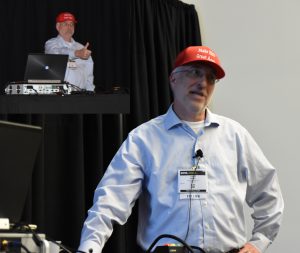Midway through the week, my first impressions have solidified into a clear view of the conference themes. I think we can call this the year of stochastics. Five years ago it was hard to get anyone to listen when you talked about stochastic effects in lithography, but today it seems to be the only thing people are talking about. What has changed? EUV lithography is close enough to reality that people can imagine, and even visualize, using EUV to make something other than test images for their SPIE paper. We can visualize making devices, devices that must yield. And it is not a pretty picture. For years we talked about progress in all the other areas of EUV lithography, with a parting comment that “EUV resists must improve” to fix the stochastic effects. But now it is clear that we must attempt to make devices with the resists we have today, and no miracles are on the horizon.
The other thing that has changed is the shift in emphasis from stochastic-induced roughness to stochastic-induced defects. It is hard for us lithographers to understand how an extra nanometer of linewidth roughness might affect our devices, but it easy for us to understand the implications of a missing contact hole.
I started my day in the Metrology conference with a session dedicated to LER/LWR measurement. Gian Lorusso introduced the “imec protocol”, his attempt to standardize the measurement of roughness (full disclosure: I was a coauthor). He began by describing an exercise imec performed where they sent a set of identical wafers to 13 companies and asked them to measure the linewidth roughness and send back the results. The answers he received varied by +/- 30%. The need for standardization in measurement is obvious. The main problem is bias in the measurements due to SEM noise (and how that bias varies with measurement conditions), so the most important recommendation is to always use unbiased measurements. He also described how the ITRS recommended measurement approach has become outdated with today’s low correlation length processes: a 2-micron line length is no longer needed. Gian’s paper is extremely important, and I hope that the imec protocol is widely followed from now on.
My first paper of the conference was in this same session, which included simulation results that were finished the night before (cutting things just a little too close!).
It may seem like I am pitching too many papers that I was a co-author on, but I am going to do it anyway. Charlotte Cutler of Dow gave an excellent talk on her use of power spectral density analysis to improve resist materials. As a resist maker, Dow regularly measures features after the lithography step (in industry jargon, ADI: after develop inspect), but has little access to after-etch results since those depend heavily on each customer’s etch process. But when it comes to roughness, it is the after-etch performance that matters. So, Charlotte needs to correlate her ADI measurements to after-etch results. Traditionally, that has meant looking at the ADI 3-sigma roughness with the assumption that a low ADI 3-sigma roughness would translate into a low after-etch 3-sigma roughness. Alas, it often does not. To explore why, she created two matrices of resist formulations and measured the power spectral densities of the roughness of each of them. She found that while after-develop 3-sigma roughness was not a good predictor of after-etch 3-sigma roughness, the after-develop unbiased PSD(0) was. I predicted last year that this approach would work (in my EUVL Symposium paper), and it is very gratifying to see this prediction proved out experimentally.
There seem to be fewer ASML papers at the conference this year (is it my imagination?), but I did catch Jan von Schoot talking about their plans for a high-NA EUV scanner. Every time I see drawing of this tool, or pictures of the lens manufacturing facility under construction at Zeiss, I am amazed at how massive and complicated this tool will be. Perhaps it is designed to make the NXE:3400 seem only moderately complex.
I walked around the poster session (much smaller than in years past), and saw quite a few good ones. The conference is now half-way over, but I won’t say it is a downhill ride from here. Wednesday will be exciting!

 I love port. The fortified wine is lovely before or after dinner, and makes me feel more sophisticated and refined than I deserve. Port is made exclusively in the Duoro Valley of northeastern Portugal, then aged in wooden barrels in the coastal city of Porto. I’ve always wanted to visit there, so when I discovered that the 2017 MNE (Micro and Nanoengineering) conference was being held in Portugal, I made a plan to attend.
I love port. The fortified wine is lovely before or after dinner, and makes me feel more sophisticated and refined than I deserve. Port is made exclusively in the Duoro Valley of northeastern Portugal, then aged in wooden barrels in the coastal city of Porto. I’ve always wanted to visit there, so when I discovered that the 2017 MNE (Micro and Nanoengineering) conference was being held in Portugal, I made a plan to attend.